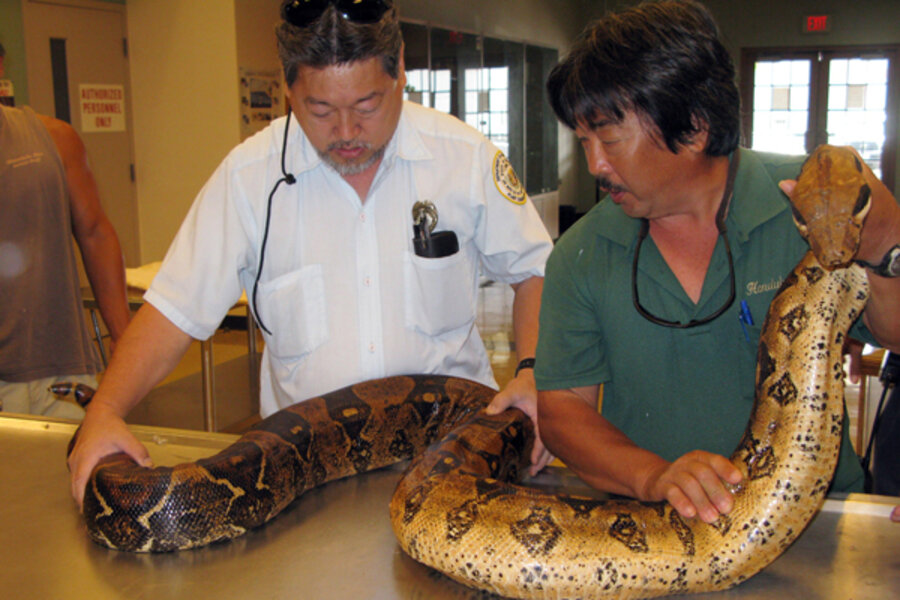Hawaii snakes: Smuggled reptiles threaten islands' fragile ecosystem
Loading...
| Honolulu
Hawaii has been largely successful in preventing snakes from entering the island paradise over the years and avoiding the grave danger they present to tropical birds, colorful plants and the vibrant environment that draws millions of tourists to the state each year.
But the recent capture of escaped pet snakes — illegal in Hawaii — and the infestation of Guam by brown tree snakes, which could easily make it here via cargo ship, have alarmed wildlife and agriculture officials.
Without any natural predators, authorities say it wouldn't take much for snakes to take root and multiply, potentially killing off endangered birds and flowers that make the islands special. Hawaii, home to more endangered species per square mile than anywhere else in the world, could potentially face the same fate as Guam, where brown tree snakes overran the island following World War II and wiped most birds from the skies.
"It has a high potential to be devastating to Hawaii," said Earl Campbell, assistant field supervisor for the Pacific Islands Fish and Wildlife Office within the U.S. Fish and Wildlife Service. "I would look at Guam as the template for what could happen in a range of tropical Pacific Islands that have no snakes."
Hawaii is so serious about keeping snakes out that the fine for possessing an illegal animal can reach $200,000 and up to three years in prison. But snake owners are granted amnesty if they willingly turn their pets over.
Residents who unlawfully keep snakes as pets create a giant risk when the reptiles escape or are released into the wild. A 9-foot boa constrictor and 7-foot albino Burmese python were captured this month.
"No pet snake is welcome because all it's going to take is the next earthquake, tsunami or hurricane to blow open all those enclosures and introduce to the islands all those pets that were being kept in a house," said Fern Duvall, a wildlife biologist for the state Division of Forestry and Wildlife on Maui. "It's really a grievous problem."
Besides the snake pet threat, environmentalists also fear that snakes could find their way to Hawaii by hitchhiking on cargo ships, undetected by short-staffed agriculture inspectors.
If snakes nested and reproduced, it would quickly be too late to stop them and the Hawaiian islands would be changed forever, said Christy Martin, spokeswoman for the state's Coordinating Group on Alien Pest Species.
"It's our moral responsibility to try to keep them out for as long as possible. I don't look forward to future generations saying, 'They really dropped the ball on that one. There used to be birds in Hawaii,'" Martin said.
The number of snake sightings fluctuates from year to year, but they've been steadily rising, said Carol Okada, manager for the Hawaii Department of Agriculture's Plant Quarantine Branch.
There was a yearly average of nearly 24 snake sightings reported statewide between 1990 and 2000, according to a 2001 study titled "Risk to Hawaii from Snakes" published in Pacific Science. Okada said there were 36 snake reports in 2008, with data from other recent years not immediately available.
"We don't want the trend to continue," Okada said. "In Hawaii, with all its lush vegetation, you don't want to be worried about snakes while you're hiking."
A snake invasion would have far-reaching effects on the islands, permanently changing its landscape, Duvall said.
First they'd eat bird eggs and small birds, including 34 species of endangered forest birds found in Hawaii such as the Maui parrotbill, crested honeycreeper and Hawaiian crow, he said. Spider webs would drape trees and darken forests without birds to kill them. Insect populations would boom. Power outages would increase as snakes hung from electricity lines.
These consequences have already occurred on Guam, according to Campbell, saying the snakes there established themselves across the landscape in about three decades.
In this month's captures on Oahu, the snakes appeared to be pets, agriculture officials said. The docile boa constrictor was found by pig hunters on a dirt road, and the python was retrieved from a home after police received a tip.
The black market pet trade is largely responsible for snakes finding their way into the islands, Martin said.
Snake enthusiasts find dealers through the Internet and ship baby snakes by mail to Hawaii in small boxes, she said. Legitimate pet stores won't send snakes to Hawaii, she said.
With only 50 agriculture inspectors statewide, down from 95 in 2009 because of budget cuts and layoffs, the state has a hard time catching snakes when they're mailed in, she said. Efforts to prevent snakes from escaping Guam have been more successful, and only one brown tree snake has been found in Hawaii since an inspection program started on Guam in 1994, Campbell said.
Organizations including the Hawaiian Humane Society help rid the islands of pet snakes by picking them up from homes with no questions asked, said spokeswoman Jacque LeBlanc.
"In the case of the boa that was found, that boa was big enough to eat a cat or harm a child," LeBlanc said. "They're dangerous to people and other animals."





